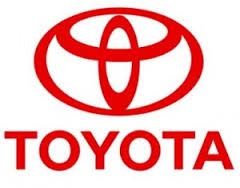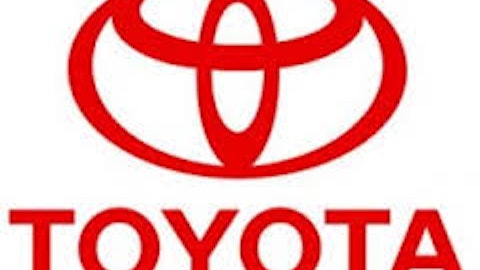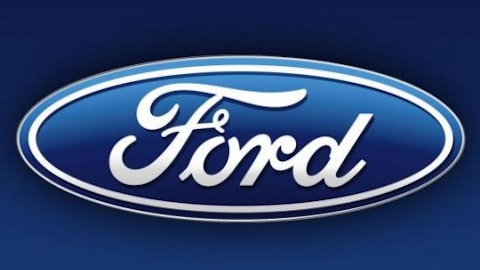Four years ago, not many among us foresaw a period of steady and generous earnings from the domestic automobile manufacturing industry. Yet, that is exactly what we have seen. Living in Michigan I feel a sense of kinship with the industry, and enjoy visiting it quarterly.
Ford Motor Company (NYSE:F) is the darling of the industry and was the lone domestic automaker to survive without government help last decade. It boasts a winning line of both desirable automobiles and superb financial results the past few years. In the fourth quarter of 2012, Ford recorded its 14th consecutive quarterly profit with $1.24 billion, or $0.31 per share, some 50% over last year’s fourth quarter, and it also beat by analysts’ expectations of $0.25 per share by 24%. The 2012 results excluded one-time events that would have added another nine cents per share to the total.

The big drag on earnings continues to be Europe, where Ford suffered a pretax loss of $732 million in the fourth quarter, and over $1.7 billion in losses in 2012. I would not be surprised to see pretax losses of up to $2 billion in Europe in 2013 if volumes continue to fall. In South America and Asia, Ford pretty much treaded water with very modest profits. Ford’s North American auto and finance businesses are carrying and will continue to carry the company in the year ahead. Ford has gotten off to a fine start to 2013 with January sales up 22% from January 2012.
There are two big issues confronting Ford in particular. It had unfunded pension obligations of nearly $19 billion at the end of 2012, and it cannot go on losing money in Europe forever, particularly as the Chinese market continues being the fastest growing, mature market in the world. Ford’s January, 2013 sales in China virtually doubled those of the year ago month. In 2013, Ford looks for modest growth in North America, improving South American economies, and strong growth in China. It sees continued recession in Europe. I would like to see the company cut back on its European assets. In 2013, with the anchor of Europe, earnings are unlikely to rise, and may even fall marginally if Ford faces any sort of setbacks elsewhere.
Tata Motors Limited (ADR) (NYSE:TTM) is the largest automobile manufacturer in India. It has a long history primarily as a bus and truck company. It is the world’s second largest medium to heavy bus maker, and fifth largest medium to large commercial truck maker. It also as a substantial car presence, due largely to its Jaguar / Land Rover division, which it purchased in 2008. In recent years due to poor economies in many of its target markets, the truck and bus divisions have not been profitable. But the luxury car division has been carrying the company, but even that came under pressure in the third quarter as currency and product mix concerns conspired to drive down margins. Those earnings have not been released as yet, but earnings for full year 2012 will not approach 2011 levels, and the headwinds are likely to persist a while longer. I see more downside than upside to Tata at this time.
Toyota Motor Corporation (ADR) (NYSE:TM) has reclaimed the title of world’s largest auto maker, and continues its comeback from years of American product recalls and Japanese natural disasters. Its fiscal year ends March 31, so in its third quarter results. Toyota’s quarterly income rose by 23%, to 100 billion yen, or $1.1 billion during its traditionally weakest quarter. The earnings were roughly cut in half by a $1.1 billion settlement of claims by the U.S. Transportation Department that Toyota was late publicizing a recall. But management now expects fiscal 2012 earnings of $9.3 billion, more than three times last year’s net. Analysts see earnings growth allowing for a five year PEG down to 0.35, the lowest of any major auto maker. If I had to choose one to go long in, I would choose Toyota.
Finally we get to General Motors Company (NYSE:GM) . General Motors has not reported year-end earnings as I write this, but had a generally solid third quarter, with earnings in the quarter of $0.89 per share exceeding expectations by nearly 50%. But the real news for General Motors it soon it will no longer be derisively be referred to as “Government Motors.” It was announced in December, 2012 that between a company purchase of government stock along with public offerings, the U.S. Treasury would liquidate what had been a 500 million share stake in the company now later than early 2014.
General Motors is continuing its success in China, with January’s 26% volume gain enough to account for company record sales in the world’s largest car market. But that is not enough to account for continuing losses in Europe. The company lost $478 million in Europe in the third quarter, and while it has in place programs to reduce spending in Europe, no one expects any quick turnarounds in that troubled economy.
Looking ahead, analysts are looking at fourth quarter and full year earnings of $0.51 and $3.26 per share. I am looking at narrowing losses in Europe, growing earnings in Japan, and stable North American earnings, and that should equal earnings growth in the high single digits looking forward. With much of General Motors’ debt being extinguished in bankruptcy, just 18% of the company’s capitalization is debt. That will help if there develop any unforeseen macro-economic problems. I like GM as a fairly safe bet as far as autos go for the intermediate to long-term.
The article A Look at 4 Big Auto Stocks in Early 2013 originally appeared on Fool.com and is written by Maxwell Fisher.
Copyright © 1995 – 2013 The Motley Fool, LLC. All rights reserved. The Motley Fool has a disclosure policy.





